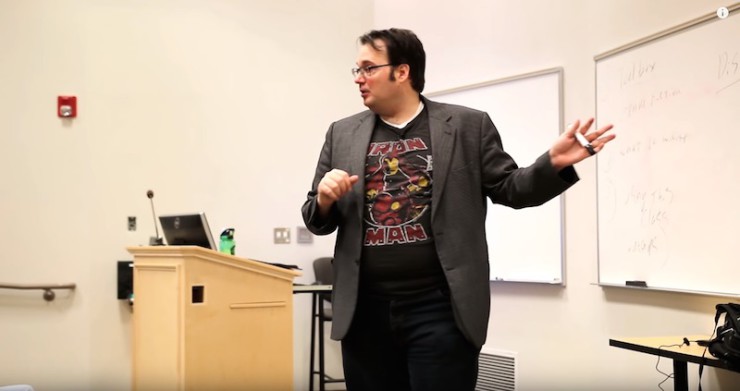There is no shortage of writing advice online from Brandon Sanderson: Go to his website, and you can click your way to 15-minute Writing Excuses podcasts as daily encouragement, or pull up a NaNoWriMo Pep Talk for when you need a big push. Starting a few years ago, Sanderson also released video lectures from his writing class at Brigham Young University, which he credits as one of the “big hallmarks” of his web presence. But as his lectures have changed and evolved over time, Sanderson has decided to rerecord his Writing Science Fiction and Fantasy class and release the 2016 Sanderson Lectures online, starting this week.
As he explains in the first lecture below, Sanderson himself took a version of this class at BYU around 1999-2000, taught by Dave Wolverton (a.k.a. David Farland). While it wasn’t his first writing class, it was the first that was truly effective, as he found that the most helpful writing advice came from people working in the business.
“There is no one way to write a story” is Sanderson’s first piece of advice, as he lays out two distinctive styles, each favored by different authors: outline versus discovery; that is, architecting your story versus flying by the seat of your pants. But while some writers will swear by one method and deride the other, Sanderson suggests a hybrid: For instance, he tends to use the discovery method with his characters, learning about them as he lets them tell their own story; then outline the plot once he knows who the characters are, so that the story doesn’t meander.
“There are as many different ways to do this as there are writers,” Sanderson says in the introduction below. The rest of the “curriculum” will include two lectures each on plotting, characters, setting, and business, and then “some wild cards.” And now, class is in session:
Sanderson will release a new video at an expected pace of once a week, with the hope that these will replace the previous series as the “canonical” version of his online writing lectures. You can find the latest link (as well as the aforementioned other writing advice) on his website.
Camera work and editing by Earl Cahill/Camera Panda










